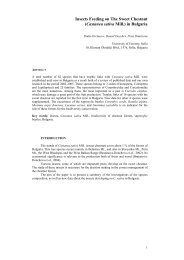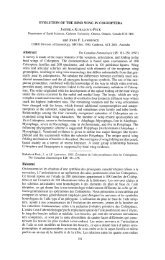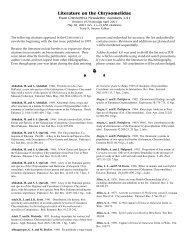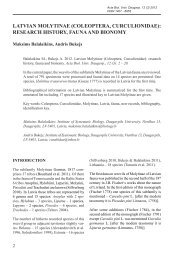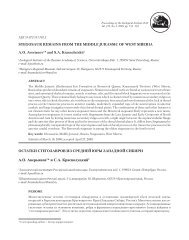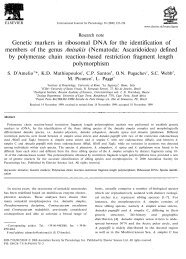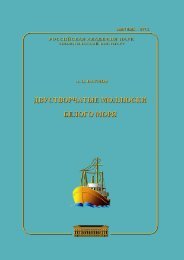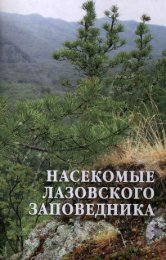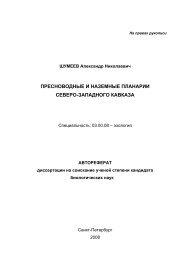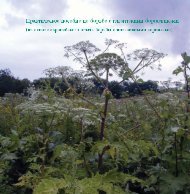Revision of the genus Mniophila STEPHENS, 1831
Revision of the genus Mniophila STEPHENS, 1831
Revision of the genus Mniophila STEPHENS, 1831
Create successful ePaper yourself
Turn your PDF publications into a flip-book with our unique Google optimized e-Paper software.
Beitr. Ent. 59 (2009) 1125covered with large, well developed shagrination. Antennal grooves not very deep. Antennae withmoderately thick and comparatively long segments. Pronotum long, quite apparently not widelyrounded, its surface covered with distinct shagrination, rarely smooth; punctation developed,not large and dense, weakly visible among surface’s microsculpture. Elytra with variable states<strong>of</strong> punctuation, usually punctation well developed, sometimes elytra almost impunctate; elytralstriae usually confused, not large; secondary punctation well developed, dense, size <strong>of</strong>ten as large asstrial punctures; interstices smooth. Notch between metathoracic cavities concave (Fig. 6H). Legsnot very thick; tibiae curved; metafemora wide; first protarsomere <strong>of</strong> male not wide. Aedeagus(Fig. 6L-N) ventrally with apical 1/4 more or less sharply narrowed to apex; apex ra<strong>the</strong>r wide,straight, with denticle; from lateral view apical 2/3 almost straight, wide, clearly narrowed toapex.Body length – 1.14-1.58 mm, width – 0.91-1.12 mm.Differential diagnosis:From M. transcaucasica sp. n. differs: in structure <strong>of</strong> aedeagus (Fig. 6L-N), ventrally withapical 1/4 more or less sharply narrowed to apex, <strong>the</strong> latter ra<strong>the</strong>r wide and straight instead <strong>of</strong>aedeagus ventrally with apical third gradually narrowed to apex; less curved tibiae (Fig. 6I, J); firstprotarsomere <strong>of</strong> male longer and thinner (Fig. 6F); eyes more convex; ocular sulci and frontalcalli more developed, apical antennal segments longer (Fig. 6K); pronotum longer (Fig. 6E),notch between metathoracic cavities concave (Fig. 6H); last metatarsomere thicker (Fig. 6G).From M. turcica differs: in structure <strong>of</strong> aedeagus, ventrally with apical 1/4 more or less sharplynarrowed to apex, <strong>the</strong> latter ra<strong>the</strong>r wide, straight instead <strong>of</strong> aedeagus ventrally with apical thirdgradually narrowed to apex, <strong>the</strong> latter almost straight; head shorter with deep antennal grooves;apical antennal segments longer; tibiae thinner and less curved; usually well developed punctation<strong>of</strong> pronotum and usually poorer developed shagrination. From M. taurica sp. n. differs: instructure <strong>of</strong> aedeagus, ventrally with apical 1/4 more or less sharply narrowed to apex, <strong>the</strong> latterra<strong>the</strong>r wide, straight, denticle well developed instead <strong>of</strong> aedeagus ventrally toward apex parallelsided,wide, apical 1/4 with straight, narrowing sides and with distinct and straight apex withra<strong>the</strong>r short, wide denticle or poorly developed; head shorter and wider, eyes more convex, apicalantennal segments longer; hind femora thicker; differs also in <strong>the</strong> shape <strong>of</strong> pronotum with lessrounded base.<strong>Mniophila</strong> transcaucasica sp. n.(Figs 7, 10)Type material:Holotype: Armenia: Kaukasus Dshelal ogly, male (ZIN). – Paratypes: Georgia: Kaukas Leder /M. muscorum Koch. Coll. Reitter, 2 males (HNHM).Caucasus. <strong>Mniophila</strong> muscorum Caucas / k. Rybakova, male (ZIN).Etymology:The specific epi<strong>the</strong>t refers to geographical distribution <strong>of</strong> <strong>the</strong> new species that is distributed inTranscaucasus.Distribution:Armenia, Georgia.




